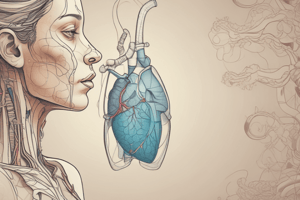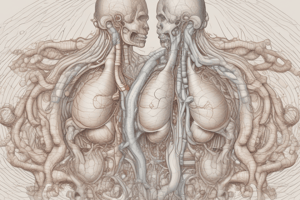Podcast
Questions and Answers
What is the primary function of oxygen in the body's cells?
What is the primary function of oxygen in the body's cells?
- To be stored in the capillary beds
- To produce carbon dioxide as a waste product
- To facilitate metabolic processes (correct)
- To be carried by plasma in the circulation
What happens to oxygen after it is taken up by haemoglobin?
What happens to oxygen after it is taken up by haemoglobin?
- It travels via RBC in circulation to the tissues (correct)
- It is used by the RBC for their metabolic processes
- It is released into the capillary beds
- It is transported to the lungs
What is the end product of cellular metabolic processes?
What is the end product of cellular metabolic processes?
- Red blood cells
- Haemoglobin
- Carbon dioxide (correct)
- Oxygen
Where is oxygen released from the red blood cells?
Where is oxygen released from the red blood cells?
How is most carbon dioxide transported in the blood?
How is most carbon dioxide transported in the blood?
When we inhale, CO2 is taken up by haemoglobin.
When we inhale, CO2 is taken up by haemoglobin.
Oxygen is released from the red blood cells in the capillary beds.
Oxygen is released from the red blood cells in the capillary beds.
The majority of CO2 is carried by red blood cells.
The majority of CO2 is carried by red blood cells.
Cells use CO2 for their metabolic processes.
Cells use CO2 for their metabolic processes.
CO2 is released when it reaches the tissues.
CO2 is released when it reaches the tissues.
When we inhale, ______ is taken up by haemoglobin.
When we inhale, ______ is taken up by haemoglobin.
Cells use the ______ for their metabolic processes.
Cells use the ______ for their metabolic processes.
The ______ is released into the tissues in the capillary beds.
The ______ is released into the tissues in the capillary beds.
Cells produce ______ as a waste product.
Cells produce ______ as a waste product.
The ______ diffuses from the tissues into the plasma in the capillaries.
The ______ diffuses from the tissues into the plasma in the capillaries.
What is the primary function of leucocytes?
What is the primary function of leucocytes?
What is the characteristic that distinguishes granulocytes from agranulocytes?
What is the characteristic that distinguishes granulocytes from agranulocytes?
What triggers the movement of leucocytes to an area of damage?
What triggers the movement of leucocytes to an area of damage?
What is the route that leucocytes take to reach an area of damage?
What is the route that leucocytes take to reach an area of damage?
What is the role of leucocytes in the healing process?
What is the role of leucocytes in the healing process?
What is the main function of leucocytes in the body?
What is the main function of leucocytes in the body?
What happens to leucocytes when they receive chemical signals from damaged tissue?
What happens to leucocytes when they receive chemical signals from damaged tissue?
What is the characteristic that distinguishes granulocytes from agranulocytes?
What is the characteristic that distinguishes granulocytes from agranulocytes?
How do leucocytes reach the area of damage?
How do leucocytes reach the area of damage?
What triggers the movement of leucocytes to an area of damage?
What triggers the movement of leucocytes to an area of damage?
Leucocytes are responsible for carrying oxygen to the body's cells.
Leucocytes are responsible for carrying oxygen to the body's cells.
Granulocytes are a type of leucocyte that lacks granules in the cytoplasm.
Granulocytes are a type of leucocyte that lacks granules in the cytoplasm.
Leucocytes can move through the walls of thick-walled capillaries.
Leucocytes can move through the walls of thick-walled capillaries.
Leucocytes travel to the area of damage through the bloodstream.
Leucocytes travel to the area of damage through the bloodstream.
The primary function of leucocytes is to aid in the healing process.
The primary function of leucocytes is to aid in the healing process.
Match the following terms with their definitions:
Match the following terms with their definitions:
Match the following types of leucocytes with their characteristics:
Match the following types of leucocytes with their characteristics:
Match the following stages of leucocyte movement with their descriptions:
Match the following stages of leucocyte movement with their descriptions:
Match the following leucocyte functions with their effects:
Match the following leucocyte functions with their effects:
Match the following anatomical structures with their roles in leucocyte movement:
Match the following anatomical structures with their roles in leucocyte movement:
What is the function of neutrophil granulocytes?
What is the function of neutrophil granulocytes?
What is unique about the granules of eosinophil granulocytes?
What is unique about the granules of eosinophil granulocytes?
Which type of granulocyte is the most common?
Which type of granulocyte is the most common?
What is the function of basophil granulocytes?
What is the function of basophil granulocytes?
What is a characteristic of basophil granulocytes?
What is a characteristic of basophil granulocytes?
What is the function of neutrophil granulocytes?
What is the function of neutrophil granulocytes?
What is unique about the granules of eosinophil granulocytes?
What is unique about the granules of eosinophil granulocytes?
What is the function of basophil granulocytes?
What is the function of basophil granulocytes?
Which type of granulocyte is the most common?
Which type of granulocyte is the most common?
What is the color of basophil granulocytes' cytoplasmic granules?
What is the color of basophil granulocytes' cytoplasmic granules?
Neutrophil granulocytes have dark purple granules in their cytoplasm.
Neutrophil granulocytes have dark purple granules in their cytoplasm.
Eosinophil granulocytes are the most common type of granulocyte.
Eosinophil granulocytes are the most common type of granulocyte.
Basophil granulocytes are involved in parasitism and allergies.
Basophil granulocytes are involved in parasitism and allergies.
Granulocytes are a type of leucocyte that lacks granules in the cytoplasm.
Granulocytes are a type of leucocyte that lacks granules in the cytoplasm.
The granules of eosinophil granulocytes are pale pinky/purple in color.
The granules of eosinophil granulocytes are pale pinky/purple in color.
Match the following types of granulocytes with their cytoplasmic granule characteristics:
Match the following types of granulocytes with their cytoplasmic granule characteristics:
Match the following types of granulocytes with their primary functions:
Match the following types of granulocytes with their primary functions:
Match the following types of granulocytes with their characteristics:
Match the following types of granulocytes with their characteristics:
Match the following types of granulocytes with their cytoplasmic granule colors:
Match the following types of granulocytes with their cytoplasmic granule colors:
Match the following types of granulocytes with their roles in the body:
Match the following types of granulocytes with their roles in the body:
Match the types of leucocytes with their functions:
Match the types of leucocytes with their functions:
Match the types of leucocytes with their characteristics:
Match the types of leucocytes with their characteristics:
Match the types of cells with their roles in the immune response:
Match the types of cells with their roles in the immune response:
Match the types of cells with their roles in the immune response:
Match the types of cells with their roles in the immune response:
Match the types of cells with their characteristics:
Match the types of cells with their characteristics:
Flashcards are hidden until you start studying




